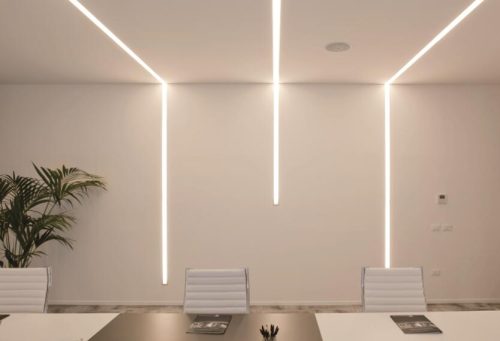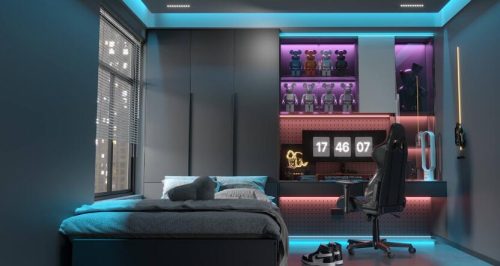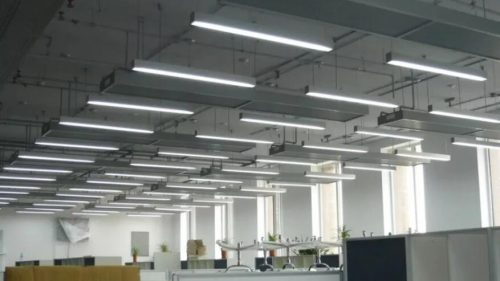
As lighting design and technology continue to evolve, a fascinating trend has emerged, captivating the attention of designers and enthusiasts alike: the soaring popularity of linear lighting.
This sleek and versatile lighting solution has swiftly become a go-to choice for both residential and commercial spaces, offering a perfect balance between form and function.
In this article, we embark on a captivating exploration of this rising phenomenon, discussing the reasons behind its surging demand and unraveling the innovative design possibilities it presents.
From its ability to create visually striking architectural accents to its seamless integration with modern technology, we will dig deeper into the captivating world of linear lighting, mainly focusing on its ever-increasing appeal in contemporary design.
What is Linear Lighting?

Linear lighting represents an innovative lighting system characterized by elongated fluorescent or LED tubes that deliver illumination in a straight and uninterrupted manner.
Its surging popularity can be attributed to a multitude of advantages, including heightened luminosity coupled with reduced energy consumption, enhanced visual appeal, and the flexibility to adapt the lighting ambiance to varying contexts and moods.
In order to truly grasp the myriad advantages associated with the seamless incorporation of linear lighting systems into both residential and commercial environments, it becomes imperative to delve deep into the extensive historical evolution and remarkable technological advancements of linear lights.
The beginning of linear lighting technology can be traced back to the 1950s, a transformative era marked by the introduction of fluorescent tubes as a groundbreaking and economically viable substitute for conventional incandescent bulbs.
The remarkable progress in technology has facilitated the emergence of an extensive range of linear lighting possibilities, encompassing cutting-edge innovations like LED lights, RGBW LED fixtures, daylight dimmable light fixtures, dynamic lenses, and tunable white lights.
Benefits of Linear Lighting
By embracing a linear lighting system, individuals can reap a host of advantages:
- These systems offer amplified luminosity while significantly curbing power consumption in comparison to conventional lighting alternatives. LED linear fixtures are designed to be energy-efficient, resulting in reduced energy consumption and lower operating costs over time.
- Linear lighting systems offer the distinct advantage of providing uniform and consistent illumination across a given space.
- The linear form factor allows for easy integration into various architectural elements, such as coves, shelves, and recessed areas.
- The versatility of linear lighting allows for the creation of captivating architectural features, which harmoniously blend with interior design aesthetics.
- The ability to customize the light color to suit various atmospheres and occasions further accentuates the appeal of linear lighting.
Aesthetics and Versatility: The Visual Appeal of Linear Lighting

Linear lighting has gained immense popularity due to its sleek and modern design, making it a visually appealing choice for lighting fixtures. The clean lines and elongated shape of linear lights bring a contemporary touch to any space, whether it’s a residential living room or a commercial office.
These fixtures have the unique ability to enhance architectural features, such as highlighting the clean edges of a modern building or accentuating the curves of an archway.
Additionally, linear lighting creates ambient effects by evenly distributing light along its length, creating a soft and uniform illumination that adds depth and sophistication to the environment.
The versatility of linear lighting further contributes to its popularity, as it seamlessly integrates into various spaces and design styles.
From suspended linear lights adding a touch of elegance to high ceilings, to recessed linear lights providing a discreet and seamless lighting solution, the design possibilities are endless.
Linear lighting allows designers to create captivating installations with corner L shapes, T and cross junctions, and custom lengths, enabling them to tailor the lighting design to fit the room perfectly.
With its sleek aesthetics and versatile applications, linear lighting has become a go-to choice for designers seeking to achieve both form and function in their lighting designs.
Technological Advancements: Integration of Linear Lighting and Smart Controls

The advent of smart lighting systems has revolutionized the way we interact with lighting, and linear lighting has seamlessly integrated with these advancements. Linear lighting fixtures now come equipped with smart controls, allowing users to customize their lighting experience with ease.
The integration of intelligent controls presents an extensive array of advantages, encompassing the unparalleled capacity to finely tune and modulate not only brightness levels but also the elusive nuances of color temperatures, thereby facilitating the creation of captivating and immersive lighting scenes that dynamically adapt to the desired atmosphere.
By a mere touch of a button or the effortless utterance of a voice command, users are bestowed with the ability to craft and curate the ideal lighting ambiance that impeccably aligns with the distinctive requirements of any given occasion.
Smart controls also contribute to energy efficiency, as they enable scheduling and automation features, ensuring that lights are only on when needed. Integration of linear lighting with home automation and IoT (Internet of Things) devices takes convenience to the next level, allowing users to control their lights remotely through their smartphones or voice assistants.
Imagine coming home to a well-lit and welcoming space, all thanks to the seamless integration of linear lighting with smart controls. This synergy between linear lighting and advanced technologies not only enhances the user experience but also provides energy-saving benefits and promotes sustainable lighting practices.
The integration of linear lighting with smart controls is a testament to the ever-evolving landscape of lighting design, where technology and aesthetics work hand in hand to create lighting experiences that are both innovative and user-friendly.
Commercial Applications: Illuminating Spaces with Linear Lighting

The inclusion of linear lighting in commercial spaces, such as retail stores, offices, restaurants, and hospitality venues, has been on the rise, driven by its ability to create captivating lighting environments.
In retail stores, linear lighting plays a crucial role in enhancing product displays and drawing attention to merchandise. The even and focused illumination provided by linear lighting fixtures ensures that products are showcased in their best light, captivating customers and encouraging sales.
In office spaces, linear lighting offers a balance between functionality and aesthetics. It provides adequate and uniform illumination, reducing glare and creating a comfortable working environment.
Linear lighting fixtures can be seamlessly integrated into architectural elements, such as suspended from exposed ceilings or recessed into cove lighting, adding a touch of sophistication to the workspace.
The hospitality industry also embraces linear lighting for its ability to create immersive customer experiences. Linear lights can be used to highlight architectural features, illuminate corridors, or create dynamic lighting scenes in restaurants and lounges, setting the mood for different occasions.
Successful linear lighting installations in these commercial settings can be seen through various case studies, showcasing how designers have utilized linear lighting to transform spaces and create visually stunning environments.
The increasing adoption of linear lighting in commercial applications reflects its versatility, adaptability, and ability to elevate the overall experience for customers and employees alike.
Residential Design: Transforming Homes with Linear Lighting

Linear lighting has made a significant impact on residential design, offering homeowners the opportunity to transform their living spaces into visually stunning and functional environments.
One of the key advantages of linear lighting in residential settings is its ability to elevate the ambiance of various rooms.
For example, in the kitchen, linear lighting can be installed above kitchen islands, under cabinets, or along countertops, providing focused task lighting for food preparation while adding a touch of sophistication to the overall design.
In living rooms, cove lighting with linear fixtures can create a warm and inviting atmosphere, accentuating architectural elements such as exposed beams or wall textures. Linear lighting also excels in accentuating artwork or highlighting specific areas of interest in a room, allowing homeowners to showcase their prized possessions.
When integrating linear lighting into residential design, several considerations come into play. The placement of fixtures, color temperature selection, and the choice of control options all contribute to achieving the desired lighting effect.
Seamless integration with the existing decor is key, ensuring that linear lighting enhances the overall aesthetic without overpowering the space.
With careful planning and thoughtful implementation, linear lighting can truly transform residential interiors, adding a layer of visual interest, functionality, and personalization to create a home that is both stylish and inviting.
Sustainable Lighting Solutions: Energy Efficiency of Linear Lighting

As the world continues to prioritize sustainability and energy efficiency, linear lighting has emerged as a frontrunner in providing eco-friendly lighting solutions.
The use of LED technology in linear lighting fixtures has revolutionized the industry, offering significant energy-saving potential and environmental benefits. LED linear lights consume much less energy compared to traditional lighting options while providing the same, if not better, levels of illumination.
This translates to reduced electricity consumption, lower utility bills, and a smaller carbon footprint. LED linear lights also have a longer lifespan, resulting in fewer replacements and reduced waste.
Furthermore, the absence of hazardous substances such as mercury makes LED linear lighting an environmentally friendly choice. Linear lighting fixtures can also contribute to achieving green building certifications, as they align with sustainability goals and energy-efficient design principles.
Architects and designers are increasingly incorporating linear lighting solutions into their projects to meet strict energy efficiency requirements and to create sustainable spaces.
The versatility of linear lighting, with its ability to be integrated into various architectural elements and its compatibility with smart controls, further enhances its energy-saving capabilities.
By combining the aesthetic appeal of linear lighting with its sustainable features, we can create a brighter and greener future, one illuminated space at a time.






